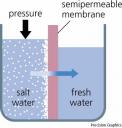Today is the MLK Holiday – my day off. I decided to replace the filters in my 5-stage reverse osmosis (RO) system (Watt’s Premier Water WP5). According to my record, it’s been almost two years already since I replaced the filters. The filters consist of a sediment filter (1st stage), two carbon block filters (2nd and 3rd stage), the membrane (not replaced this time due to its high cost ~ $60) and the final finishing filter or GAC filter. As it turns out, the filters were not that badly soiled. Compared to my experience in my previous San Jose home, the Sunnyvale water is a lot cleaner.
GAC = Granular activated charcoal is made from raw materials (such as coconut shells or coal) that are high in carbon. Heat is used to increase (activate) the surface area of the carbon; this is why these filters are sometimes referred to as “charcoal” filters. The activated carbon removes certain chemicals that are dissolved in water passing through a filter containing GAC by trapping the chemical in the GAC. However, other chemicals, like sodium or nitrate, are not attracted to the carbon and are not removed.
I first shut off the valve to the RO system and proceeded drained the clean water, ~ 2 gallons, from the storage tank until the water is completely drained out. I then replaced the filters from the 1st stage to the last. This took me about 1/2 hour. The key things to watch out for: 1) Have a large towel already to handle the excessive water during the removal process – even after the valve is shut off. 2) Use the paper towel to clean the inlets of the cartridges and the inside surface of the cartridges. 3) Use Teflon tape to seal the threads on the tubes going into and out of the last GAC filter.
After I was done with it, I checked the Internet for several interesting facts for my own knowledge.
1. The principle of reverse osmosis was first apply to getting solvent out of solution. It’s very interesting that the membrane act as a barrier to separate out large molecules (impurities, minerals and etc.) from the clean water. The clean water will infiltrate into the dirty water to reach an equilibrium – an osmosis process. By applying the pressure on the raw water side, thus the name “reverse osmosis,” one can separate out the clean water. It’s like using the city’s water pressure topush the clean water through the membrane, which traps the impurities. The residual impure water gets flushed out of the RO system as brine water. More diagrams below. The salt water de-salination works the same way.


2. The zero-waste RO system redirects the brine (waste) water back to the hot water faucet for recovery. Not sure what purpose this would serve. My experience is that they tend to get drained out first because it isn’t hot enough in the first place.

3. The permeate pump is an interesting concept to reduce the water waste. By regulating/reducing the permeate output pressure, the RO membrane can work more efficiently, wasting less water or producing less brine water. A good explanation of how it works is here.
My conclusion is that I like to keep things simple. Having more parts and more interconnects will likely make the system less reliable, thus susceptible to water leaks and other maintenance issues. The water waste is not that bad for a 3-member household like mine. It’s much harder for me to justify adding the complexity just to save a few gallons of water. Yesterday, I visited Costco and saw a new version of RO system that has a quick-release for the filters, thus making the filter replacement work a lot easier. It’s definitely a step in the right direction. They would sell more filters (~$20 per set of 4 filters, except for the membrane) because the filters are much easier to replace.



